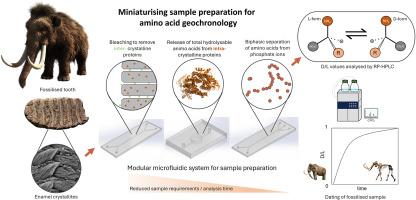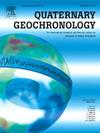“猛犸流体”:使用模块化微流体系统对哺乳动物牙釉质化石进行氨基酸定年
IF 2.5
2区 地球科学
Q3 GEOGRAPHY, PHYSICAL
引用次数: 0
摘要
对化石样本定年有助于重建进化史,有助于保护工作和减轻气候变化的影响。利用晶体内蛋白质分解(IcPD)方法对牙釉质进行氨基酸年代学研究,可以在第四纪时间尺度(~ 250万年)上对哺乳动物的牙齿进行直接测年,超出了放射性碳测年(~ 5万年)的限制。然而,目前的方法需要专业设备和相对较长的处理时间。我们开发了一种用于牙釉质样品手性氨基酸分析的模块化微流控系统,该系统由三个连续的玻璃微流控装置组成,用于样品漂白、可水解氨基酸的释放和双相分离。采用反相高效液相色谱法(RP-HPLC)测定关键氨基酸的相对浓度和D/L值。微流控方法将样品量从~ 15 mg减少到~ 1 mg,漂白时间从72 h减少到2 h。现代和化石样品的氨基酸组成在微流控方法和标准IcPD方法之间相似,苯丙氨酸(Phe)和谷氨酸(Glx)的D/L值高达~ 0.5。该方法适用于不同种类和操作人员,减少了样品质量和分析时间。这种方法可以减少对珍贵化石样本的破坏性采样,并使非专业实验室的准备步骤成为可能,从而有可能在化石所在国家进行IcPD定年。本文章由计算机程序翻译,如有差异,请以英文原文为准。

‘Mammothfluidics’: Amino acid dating of fossil mammal tooth enamel using a modular microfluidic system
Dating fossil samples helps reconstruct evolutionary history, aiding conservation efforts and mitigating climate change impacts. Amino acid geochronology of tooth enamel using the intra-crystalline protein decomposition (IcPD) approach allows direct dating of mammal teeth over Quaternary timescales (∼2.5 million years), beyond the limits of radiocarbon dating (∼50,000 years). However current methods require specialist equipment and relatively lengthy processing times. We developed a modular microfluidic system for chiral amino acid analysis of tooth enamel samples, consisting of three sequential glass microfluidic devices for sample bleaching, release of hydrolysable amino acids, and biphasic separation. Relative concentrations and D/L values of key amino acids were measured using reverse-phase high performance liquid chromatography (RP-HPLC). The microfluidic method reduced sample amounts from ∼15 mg to ∼1 mg and bleaching time from 72 h to 2 h. Amino acid compositions of modern and fossil samples were similar between the microfluidic approach and standard IcPD method, with good agreement up to D/L values ∼0.5 for phenylalanine (Phe) and glutamic acid (Glx). The method worked successfully across various genera and operators, with reduced sample mass and analysis time. This approach results in less destructive sampling of precious fossil samples and enables preparation steps in non-specialist labs, potentially allowing IcPD dating within the fossils’ country.
求助全文
通过发布文献求助,成功后即可免费获取论文全文。
去求助
来源期刊

Quaternary Geochronology
地学-地球化学与地球物理
CiteScore
4.40
自引率
22.20%
发文量
130
审稿时长
20 weeks
期刊介绍:
Quaternary Geochronology is an international journal devoted to the publication of the highest-quality, peer-reviewed articles on all aspects of dating methods applicable to the Quaternary Period - the last 2.6 million years of Earth history. Reliable ages are fundamental to place changes in climates, landscapes, flora and fauna - including the evolution and ecological impact of humans - in their correct temporal sequence, and to understand the tempo and mode of geological and biological processes.
 求助内容:
求助内容: 应助结果提醒方式:
应助结果提醒方式:


